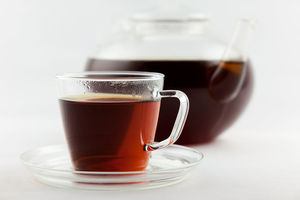
Rooibos Tea - Friend or Foe?
Spoiler alert: This new kid on the block is packed with health benefits!
Veteran health afficionados are well aware of the many health benefits of green, white, and oolong tea, but rooibos tea is just hitting its stride as a mainstream beverage for tea lovers. But what is this stuff? And how does it stack up in terms of health (and safety) to our reigning champion – green tea?
History of Rooibos Tea
Unlike most teas, rooibos is derived from the aspalathus linearis leguminous bush which is native to the mountains of Cape Province, South Africa. It was first mentioned by the botanist Carl Thunberg in 1772 as a beverage used by the locals. By the early 1900’s, rooibos tea was cultivated on an expanding scale, with greater attention to seed selection and other methods of production. With the advent of World War II and the temporary decline in Asian tea trade, rooibos tea surged in popularity briefly, only to decline and stabilize in the mid 1950’s. Today the tea is gaining recognition as a caffeine-free tea alternative with antioxidants, quercetin, low tannins, and even enough fluoride to inhibit dental cavities.[1]
Research Studies
Powerful Antioxidant / Antimutagenic
The medical literature is littered with studies revealing the phenolic content of rooibos tea[2][3] as well demonstrating the benefits of these polyphenols.
The antioxidant activity of aspalathin, the major flavonoid of unfermented rooibos tea, was compared with that of other polyphenols present in rooibos tea, α-tocopherol, BHT, and BHA using the β-carotene bleaching, α,α-diphenyl-β-picrylhydrazyl (DPPH) radical scavenging, and automated Rancimat methods. The phenolic compounds include the flavonoids vitexin, rutin, quercetin, luteolin, isoquercitrin, (+)-catechin, and the phenolic acids protocatechuic acid, caffeic acid, p-hydroxybenzoic acid, p-coumaric acid, ferulic acid, syringic acid, and vanillic acid.[2]
It was shown to reduce age-related lipid peroxides in rat brains.[4]
Rooibos tea is a powerful anti-oxidant, but green tee still reigns supreme:
Antioxidant activity as assessed with the β-carotene bleaching method decreased in the order: green > black > oolong > fermented rooibos > unfermented rooibos > semifermented rooibos. However, antioxidant activity as assessed by the DPPH radical scavenging method decreased in the order: green > unfermented rooibos > fermented rooibos > semifermented rooibos > black > oolong.[5]
Anti-inflamatory effects of rooibos were demonstrated using a rat colitis model.[6]
The antimutagenic effects of rooibos tea extracts at concentration levels consumed by humans were shown in mice using micronucleus induction.[7]
Rooibos reduces oxidative stress in Streptozotocin-induced diabetic rats.[8]
Research study using a mouse model shows antioxidant compounds in rooibos tea provide a radioprotective effect.[9]
Rooibos tea extract shows protective effect on DNA (in vitro).[10]
Study of 40 volunteers drinking 6 cups of traditional (red, fermented) rooibos tea for 6 weeks improved cholesterol markers and lipid profile, while decreasing markers of inflammation.[11]

Rooibos extract inhibits tumor formation in mouse skin.[12] However, I should note that the same study showed green tea with an inhibition rate of 100%, compared to rooibos at 60%.
Animal studies showing hepatoprotective effects of rooibos.[13][14]
Anti-Spasmodic
Rooibos tea has anti-spasmodic properties and is commonly used to control diarrhea.[15]
Red or Green?
The research is quite clear that despite red rooibos being the traditional method of preparation, it’s the unfermented, green rooibos that has the highest antioxidant and antimutagenic profile. Just look at the results of these studies:
Results indicated that the fermented tea had a significantly (P < 0.05) lower antimutagenic and antioxidant potential than the unfermented tea.[16]
Fermentation decreased the anti-radical capacity of the aqueous extracts and crude phenolic fractions.[17]
The Total Antioxidant Activity of unfermented rooibos (0.8 Trolox meq/g) resulted 2-fold higher than that of the fermented rooibos. When compared with different water infusions of Camellia sinensis (green and black tea), this TAA value was about 50% lower.[18]
Safety
Animal model studies indicate both herbal teas possess potent antioxidant, immune-modulating and chemopreventive actions. However, **human studies of rooibos are limited and of honeybush are absent. No adverse effects of rooibos or honeybush consumption as tisanes have been reported**.[19]
Drink Rooibos Tea for Diversity
Our ancestors likely evolved consuming a diverse array of plants and animals, yet most tea drinkers consume multiple cups each day derived from the same plant – Camellia sinensis. Green tea, white tea, black tea, and oolong tea are all made from the leaves of the same shrub. Why not add a little diversity to your cup of tea?
TL; DR
- Rooibos is caffeine free, high in polyphenols and anti-oxidants, and a nice addition to a tea drinker’s arsenal.
- Early research indicates health benefit, but human studies are somewhat lacking.
- Unfermented (green) rooibos has greater antioxidant and phenolic activity than fermented (red) rooibos.
- Green tea has more and better evidence supporting its use, but rooibos is an excellent addition, especially for a caffeine free beverage.
Product Recommendations
- Organic Green Rooibos Tea
- unfermented for higher antioxidant activity
- Organic Red Rooibos Tea
- most common form of Rooibos tea (fermented)
References
- https://www.jstor.org/stable/4254477?seq=1#page_scan_tab_contents
- http://pubs.acs.org/doi/abs/10.1021/jf960281n
- http://pubs.acs.org/doi/abs/10.1021/jf025697h
- http://www.sciencedirect.com/science/article/pii/030439409511853O
- http://www.sciencedirect.com/science/article/pii/S0308814696003123
- http://onlinelibrary.wiley.com/doi/10.1111/j.1442-200X.2009.02835.x/full
- http://www.sciencedirect.com/science/article/pii/002751079390187K
- http://search.proquest.com/openview/33c3bfc114aa9686653680e63fb8c202/1
- http://www.sciencedirect.com/science/article/pii/0027510795001166
- http://content.iospress.com/articles/biofactors/bio00716
- http://www.sciencedirect.com/science/article/pii/S0378874110006379
- http://www.sciencedirect.com/science/article/pii/S0304383504008687
- http://www.ownmultiplesclerosis.com/wp-content/uploads/2013/06/53_515.pdf
- http://www.biomed.cas.cz/physiolres/pdf/52/52_461.pdf
- http://onlinelibrary.wiley.com/doi/10.1111/j.1742-7843.2006.pto_507.x/full
- http://pubs.acs.org/doi/abs/10.1021/jf000802d
- http://www.sciencedirect.com/science/article/pii/S0963996903001455
- http://pubs.acs.org/doi/abs/10.1021/jf0347721
- http://onlinelibrary.wiley.com/doi/10.1002/ptr.1992/full

